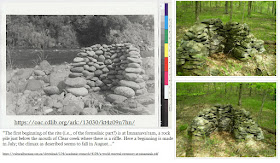“The first beginning of the rite (i.e., of the formulaic part) is at Imnanava'ram,
A KARUK WORLD RENEWAL CEREMONY AT PANAMINIK BY PHILIP
DRUCKER
“The entire ceremony, called ira'hip, or pikia'vish,
"to make again" (both names were used), was performed annually for
the purpose of ensuring plenty of food and freedom from sickness for the
ensuing year. The esoteric part was a sort-of perambulatory ritual, in which
the priest recited formulas and visited a number of sacred spots in the near-by
hills, one each day in a fixed sequence. The exoteric feature was the
performance of a white deerskin dance on the last two days and nights of the
ceremony by the people from Panaminik and adjacent towns. This dance was
actually given only every other year; on the alternate years there was a feast
given by the rich men of Panaminik. The dramatis personae of the ira'hip were: ikha'riara,
or fatawe'na, "first-spirit person," the priest who knew and
performed the esoteric rites; pishi'shikiya'- wun, the woman who cooked the
priest's single daily meal of dried salmon and acorn mush during the ritual;
several assistants to the priest, including two girls (kiya'wun) and a youth,
whose functions seem to have been omitted in the last few performances; and
last but by no means least, the rich men, who provided the objects of value for
display in the dance and food for the feasting. The role of priest could be
taken by any man belonging to Panaminik who knew the ritual. In the ceremonies
in which the informants took part it was customary for several men to relieve
one another as priest, each serving for two or three days, because the slim diet,
hill-climbing, and loss of sleep made the priest's role an arduous one…”
“On reaching the sacred spot, a small circular clearing in
the brush, the priest first had to clear away the year's accumulation of leaves
and twigs, after which he gathered a pile of wood. He laid some tinder on a
small flat stone, lighted it with his fire drill, then set stone and all under
the wood laid on the fireplace. While the fire burned, the priest sat on a flat
rock to one side, smoking his pipe. He did not pray at this time. After the
fire had died down (and he tried to time it so that he might return to the
sweat house by dusk), he removed from the embers the small stone on which the
tinder had been placed, throwing it on a pile of other stones which had been
used thus in previous years…”
“The first beginning of the rite (i.e., of the formulaic
part) is at Imnanava'ram, a rock pile just below the mouth of Clear creek where
there is a riffle. Here a beginning is made in July; the climax as described
seems to fall in August. The ceremony as a whole clearly centers about Inam, on
a flat on the s side of Clear creek, and it is to be assumed that in this town
stood the sweat house specially connected with the formulist's activities.”
January 10, 1936



Thanks for this Tim.
ReplyDeleteAn imaginative investigator might ponder the possibility that Renewal Ceremonies might have also have begun at the similar semi-circular stacked stone structure on that remarkable hill behind your childhood home...
ReplyDeleteI was thinking about that (Woodbridge "crescent"). It was more like an oven but...maybe.
ReplyDeleteI found this blog post about Pikiavish and Pauggusset absolutely fascinating! The detailed insights into these Native American tribes and their history are truly enriching.
ReplyDeletecan you buy gas with walmart gift card
I found this blog post about Pikiavish and Pauggusset really fascinating! It's always great to learn about lesser-known places and their unique histories.
ReplyDeleteHow Does Getupside Make Money
"I appreciate your commitment to diversity and inclusion in your blog. Your thoughtful discussions on these topics are so important in today's world."
ReplyDeletepiada coupon